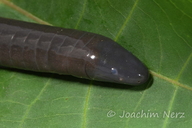|
Schistometopum gregorii (Boulenger, 1895)
East African Flood Plain Caecelian | family: Dermophiidae genus: Schistometopum |
| Species Description: Boulenger, G. A. 1895 "1894". Third report on additions to the batrachian collection in the Natural-History Museum. Proceedings of the Zoological Society of London 1894: 640–646. | |
|
Etymology: The genus, "Schistometopum" is a Latin neuter noun meaning "split forehead" (Nussbaum and Pfrender 1998). Schistometopum gregorii was named for the geologist, J.W. Gregory who collected the holotype (Channing and Howell 2006; Nussbaum and Pfrender 1998). |
|
 © 2016 Dr. Joachim Nerz (1 of 12) |
|
|
|
Description Description: Both male and female adults range from 160 to 330 mm in snout-vent length (Harper et al. 2010). Total lengths for Shistometopum gregorii are between 150 mm and 350 mm. Average number of primary annuli is 114.3 for males and 114.5 for females (ranging from 110 to 119) (Harper et al. 2010; Nussbaum and Pfrender 1998). Average number of secondary annuli is 46. Average number of complete secondary annuli is about 11 (Nussbaum and Pfrender 1998). Small scales can be found in the skin. S. gregorii has visible eyes. (Channing and Howell 2006). Coloration: S. gregorii has a black body that is grey to brown throughout. The head is usually a shade of grey and is usually different from the body coloration. (Channing and Howell 2006; Harper et al. 2010). Distribution and Habitat Country distribution from AmphibiaWeb's database: Kenya, Tanzania, United Republic of
Life History, Abundance, Activity, and Special Behaviors While little is known about reproduction in S. gregorii, it is a viviparous and most likely a precocial species (Channing and Howell 2006; Harper et. al. 2010). Adults eat soil macroinvertebrates such as earthworms and termites (Channing and Howell 2006; Harper et. al. 2010). Larva Trends and Threats Comments Schistometopum gregorii was first described by Boulenger in 1894 and was previously named Dermophis gregorrii and Bdellophis unicolor (Frost 2011).
References
Channing, A., and Howell, K. M. (2006). Amphibians of East Africa. Cornell University Press, Ithaca. Frost, D. (2011). Amphibian Species of the World: an Online Reference. Version 5.5. Gower, D. J., and Wilkinson, M. (2002). ''Phallus morphology in caecilians (Amphibia: Gymnophiona) and its systematic utility.'' Bulletin of the Natural History Society of London (Zoology), 68, 143-154. Harper, E. B., Measey G. J., Patrick D. A., Menegon M., and Vonesh J. R. (2010). Field Guide to Amphibians of the Eastern Arc Mountains and Coastal Forests of Tanzania and Kenya. Camerapix Publishers International, Nairobi, Kenya. Loader, S., Howell, K., Gower, D., Measey, J., and Wilkinson, M. (2004). Schistometopum gregorii. In: IUCN 2010. IUCN Red List of Threatened Species. Version 2010.4. www.iucnredlist.org. Downloaded on 14 April 2011. Nussbaum, R.A. and Pfrender, M.E. (1998). ''Revision of the African caecilian genus Schistometopum Parker (Amphibia: Gymnophiona: Caeciliidae).'' Miscellaneous Publications Museum of Zoology, University of Michigan, 187, 1-32. Originally submitted by: Karen Sorenson, Yu-Huan Wu, and Mary Watson (first posted 2011-04-21) Distribution by: Hong Nguyen (updated 2025-01-13)
Life history by: Hong Nguyen (updated 2025-01-13)
Larva by: Hong Nguyen (updated 2025-01-13)
Comments by: Hong Nguyen (updated 2025-01-13)
Edited by: Mingna (Vicky) Zhuang, Kellie Whitaker (2025-01-13) Species Account Citation: AmphibiaWeb 2025 Schistometopum gregorii: East African Flood Plain Caecelian <https://amphibiaweb.org/species/1936> University of California, Berkeley, CA, USA. Accessed May 3, 2025.
Feedback or comments about this page.
Citation: AmphibiaWeb. 2025. <https://amphibiaweb.org> University of California, Berkeley, CA, USA. Accessed 3 May 2025. AmphibiaWeb's policy on data use. |



 Map of Life
Map of Life